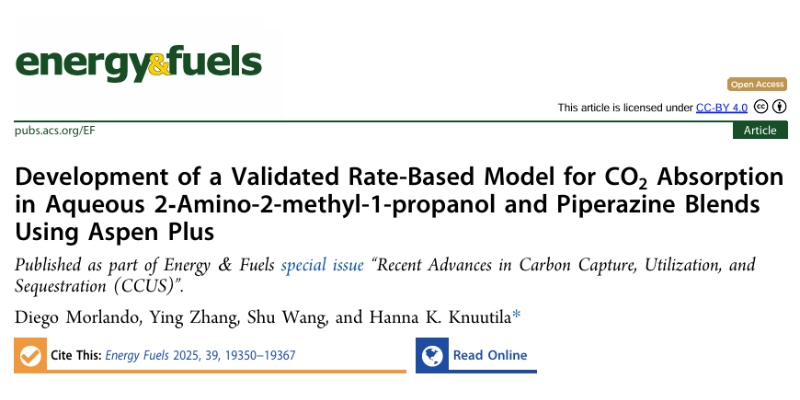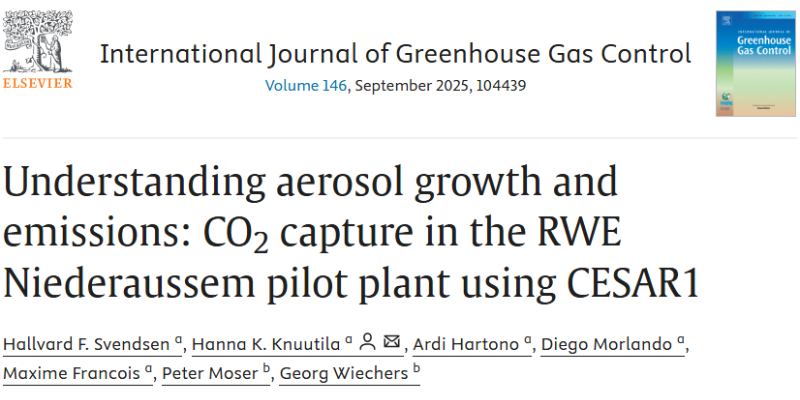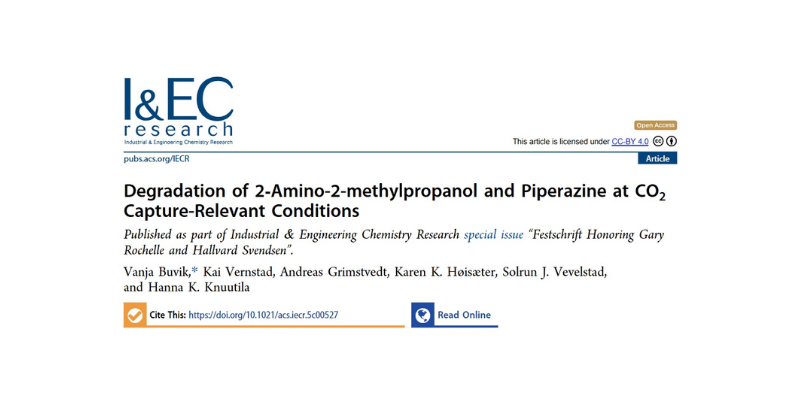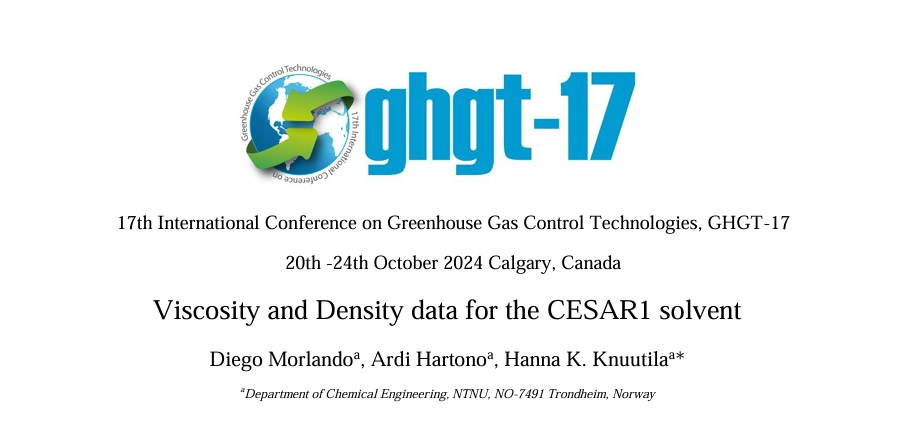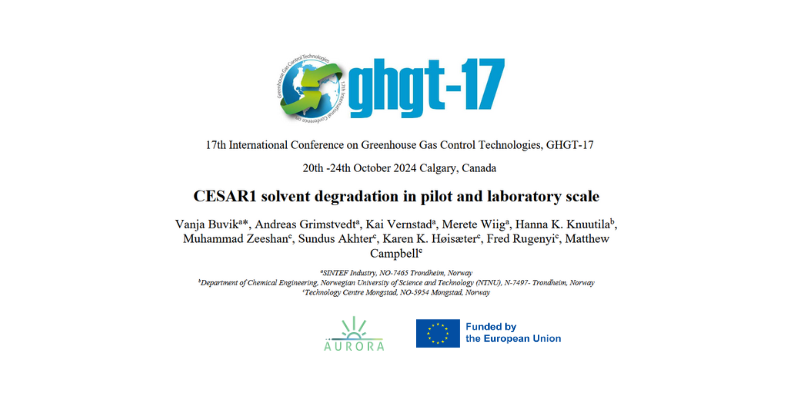A chemical mixture called CESAR1 is being widely studied as a solvent to capture carbon dioxide (CO₂) from industrial emissions (like power plants). CESAR1 is made up of two chemicals: AMP (2-amino-2-methyl propanol) and PZ (piperazine). It’s more stable and degrades less over time compared to another common solvent called MEA (monoethanolamine), even when exposed to heat, oxygen, and the tough conditions of CO₂ capture plants.
However, to safely use CESAR1 on a large scale, scientists need to fully understand how it breaks down (degrades) over time. Even though it degrades less than other solvents, some of the resulting breakdown products could impact the environment, plant safety, or nearby communities.
In this work, researchers are closely studying how and why CESAR1 degrades under realistic industrial conditions. By running experiments under heat and oxygen exposure, they are comparing lab results with real-world samples taken from CO₂ capture plants.
Recent research has already identified and measured over 30 specific CESAR1 degradation products—these include compounds like acetone and formaldehyde, which are chemicals that can form as the solvent breaks down. The research also measures the amounts of the two main solvent components, AMP and PZ, in used CESAR1 samples. A special test called total nitrogen (TN) analysis is also used to make sure no nitrogen-based compounds are missed in the breakdown process.
So far, a sample of CESAR1 taken from a test facility in Norway (the Technology Centre Mongstad, TCM) has been analyzed. This sample revealed the presence of many known degradation compounds, but most were found at very low levels. Overall, this detailed work is helping scientists ensure that CESAR1 can be safely used for large-scale CO₂ capture without unforeseen risks.
Key Terms Simplified
- Solvent: A liquid chemical that absorbs CO₂ from gases emitted by industrial plants.
- Degradation: When a chemical breaks down into smaller, often less stable parts due to heat, oxygen, or other stressors.
- Post-Combustion CO₂ Capture: A technology that removes CO₂ from flue gases after fuel (like coal or gas) is burned.
- AMP (2-amino-2-methyl propanol) and PZ (piperazine): The two chemicals that make up CESAR1 and help it capture CO₂.
- Degradation Products: New chemicals formed when CESAR1 breaks down. Some can be harmful or need careful monitoring.
- LC-MSMS: A very precise laboratory technique used to identify and measure tiny amounts of chemicals in a sample.
- Total Nitrogen (TN) Analysis: A test to see if all nitrogen-containing compounds are accounted for in a degraded solvent sample.
This research is uncovering exactly how CESAR1 behaves over time in CO₂ capture systems. By identifying its breakdown products, scientists can ensure it’s safe, reliable, and ready for use in reducing CO₂ emissions on an industrial scale.
Publication – Development of a Validated Rate-Based Model
Abstract In this work, we developed a new e-NRTL thermodynamic framework for CO2 absorption in aqueous mixtures of 2-amino-2-methyl-1-propanol (AMP) and piperazine (PZ) in Aspen Plus. The e-NRTL AMP/PZ/H2O/CO2 model was fitted on experimental data covering a range of AMP concentration from 12 to 48 mass % and PZ concentration…
Publication – Pilot-scale CO2 capture in a cement plant with CESAR1
Abstract Carbon capture from hard-to-abate industries is essential. This study investigates the effect of stripper pressure on the performance of amine-based CO2 capture from cement flue gas, using the CESAR1 solvent. Through a rigorous data filtering and binning methodology, experimental results were systematically categorized, enabling a precise evaluation of how…
New Publication: Aerosol Modeling in CO2 absorption using CESAR1
We are proud to announce that Hallvard F. Svendsen, Hanna K. Knuutila, Ardi Hartono, Maxime Francois and Diego Morlando at NTNU, together with external collaborators Peter Moser (RWE) and Georg Wiechers (RWE) have published a new article presenting results from the AURORA and SCOPE projects.The publication introduces a new class-based…
Thermodynamic Properties of CO₂ Absorption in CESAR1 — Essential Data for Better Process Modelling
We are proud to announce a new scientific publication from the AURORA project, authored by Diego Morlando, Ardi Hartono and Hanna K. Knuutila, published in Carbon Capture Science & Technology. This important work provides extensive experimental data on the thermodynamic properties of CESAR1, a key solvent blend for industrial carbon…
Journal Publication – In-Depth Study of CESAR1 Solvent Degradation Under CO₂ Capture Conditions
A new scientific publication based on research from the AURORA project has just been released in the journal Industrial & Engineering Chemistry Research. This study delivers an in-depth analysis of the degradation behaviour of the CESAR1 solvent —a popular choice for solvent-based post-combustion CO₂ capture.This work, developed under the AURORA…
Conference publication – GHGT-17: Viscosity and Density data for the CESAR1 solvent
Abstract Global warming is a major issue that needs to be addressed and limited. The CESAR1 solvent blend has a high potential for becoming a commonly employed, commercial solvent system. In this work, the viscosity and density data for aqueous CO2 loaded CESAR1 (26.6 wt.% AMP 12.8 wt.% PZ) solution…
Conference publication – GHGT-17: “Storage potential evaluation of eastern Mediterranean area as final step of the full chainassessment”
The final step in capturing and storing carbon dioxide (CO₂) emissions is geological storage, where CO₂ is injected deep underground into carefully chosen locations. These locations could be natural formations like saline aquifers (underground reservoirs filled with salty water) or empty oil and gas fields.This work, part of the AURORA…
Understanding Solvent Degradation in CO₂ Capture – CESAR1 Solvent Degradation in Pilot and Laboratory Scale
The fight against climate change requires innovative solutions, and one promising method is CO₂ capture and storage (CCS). CCS involves capturing carbon dioxide from industrial emissions before it reaches the atmosphere. At the heart of this process are specialized chemical solvents, such as CESAR1, which absorb CO₂ from flue gases.While…
Turning Waste Into Opportunity: Thermal Reclamation Chemistry of Common Amine Solvents
CO2 capture technology is vital for reducing greenhouse gas emissions. But what happens when the chemicals used in this process wear out or degrade? Scientists have been studying how to rejuvenate these chemicals through a method called thermal reclaiming. This research focuses on ethanolamine (MEA), a widely used solvent for…
Closing Knowledge Gaps – Density and Viscosity of Unloaded and CO2-loaded Aqueous AMP-PZ blends
AURORA’s latest scientific journal publication provides experimental density and viscosity data on different unloaded and CO2-loaded aqueous blends of 2-amino-2-methyl-1-propanol (AMP) and piperazine (PZ) used for absorption-based CO2 capture. The paper also provides correlations for density and viscosity suitable for various modelling works.In our previous review article, we identified knowledge…


